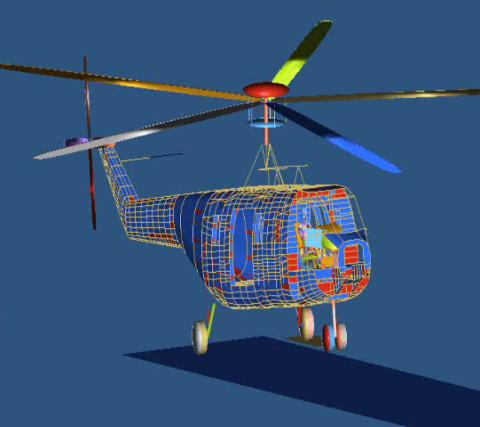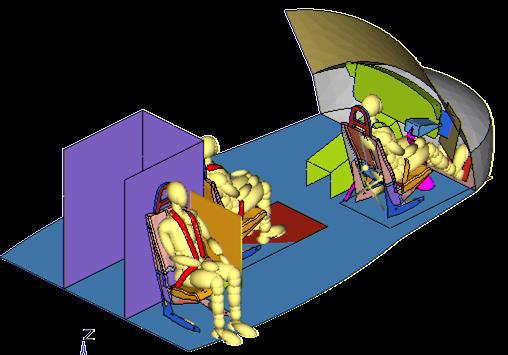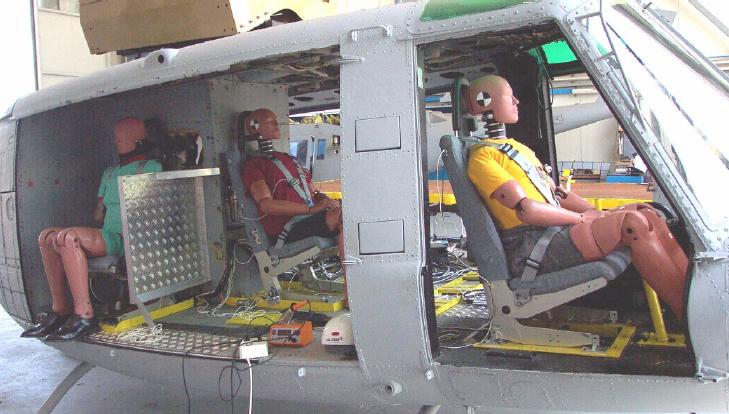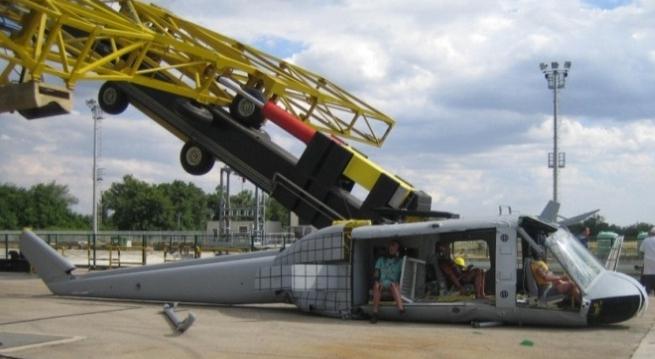Improving passive safety in crashes
Submitting Institution
Coventry UniversityUnit of Assessment
General EngineeringSummary Impact Type
TechnologicalResearch Subject Area(s)
Engineering: Civil Engineering
Summary of the impact
This case study describes the international impact of research in the
computer modelling and
simulation of automotive and aerospace crashes, undertaken by Professor Blundell.
The main
impacts arising from the research can be summarised as:
Economic impact and impact on passenger safety: i) our research
has led to improvements in
the MADYMO software suite, the `industry standard' software for safety
design and virtual crash
testing, which is produced by TNO Automotive Safety Solutions (TASS) and
sold to all the main
equipment manufacturers in the automotive and aerospace sectors ii) our
research has reduced
the costs of these equipment manufacturers, who can simulate a crash
rather than undertake
expensive, physical, crash tests iii) by improving MADYMO, our research
has had an impact on
passengers who are now travelling in cars and aircraft which safer as a
result of MADYNO's
enhanced capabilities.
Impact on practitioners and professional services: through working
with Blundell and his
group, Autoflug GmbH has learned how to incorporate advanced simulation
into its product
development process. The work has also transferred practices from the
automotive sector into
aviation. Blundell's research has helped to introduce
manufacturers and European regulators to
new methods to design safety systems to helicopters, an area previously
underdeveloped as an
area in aviation occupant crash protection.
Beneficiaries include Autoflug GmbH, TASS and its customers, and
European aviation regulators.
Underpinning research
The underpinning research in automotive and aerospace safety described in
this case study has
been undertaken by Professor Blundell and colleagues over the last
15 years, much of it in
collaboration with a number of industrial partners. This included major
programmes of research
[1,3] in vehicle dynamics and safety coordinated by Professor Blundell.
The research has been
diverse in application and sector but has had a common theme of
developing, validating and
assessing the effectiveness of computer simulation for engineering design
in vehicle dynamics and
crash safety. It has included work on pedestrian impact, vehicle
roll-over, airbag deployment,
adaptable vehicle structures and human body modelling.
A particular highlight of Blundell's work has been the €4.8M EU
FP6 project HeliSafe TA
(Helicopter Occupant Safety Technology Application), which ran from 2003
to 2007. The project
researched the simulation of helicopter crashes, which often kill
occupants who would have
survived automotive accidents of similar severity. The project had 12
partners from 7 countries,
and the computer simulations developed at Coventry University informed the
requirements for an
extensive range of helicopter crash tests performed in Germany, Spain and
Italy. During the
project, Blundell and his team worked with project partners TASS
to develop their industry
standard MADYMO software, used globally by the automotive and aerospace
industries to
simulate crashes and improve occupant crash protection. In addition to
helicopter safety, areas of
application of the work with TASS includes projects addressing vehicle
rollover, adaptable car
structures for occupant crash protection, pedestrian impact, human body
modelling and the
simulation of airbag deployment.
The simulation methodologies used throughout this work were multi-body
dynamics, finite element
methods or a combination of both. Blundell's ability to bring
transferable automotive knowledge
and capability to the project was an important contributor to the success
of Helisafe. The main
focus of the project was to design for post-crash risks including those
associated with rollover on
ground impact, operation over open water, or operation in remote areas
where rescue may be
delayed. In all cases, it was important to develop solutions that would
mitigate occupant injury and
enable them to leave the helicopter after a crash. The attention
throughout was on the interior of
the cockpit and cabin, with the particular focus on improving seats and
harnesses, and for the first
time to consider and evaluate the use of automotive airbag technology in a
civilian helicopter.
The Helisafe test programme used three crash test dummies representing
the pilot, a forward
facing passenger and a side seated passenger. Full-scale computer models
of the helicopter were
developed, including representations of: a) the interior of the cockpit
and cabin areas, b) all three
occupants and c) the new safety concepts. Non-destructive sled testing was
performed using
structural mock-ups for the pilot dummy and cockpit area at Siemens in
Germany, and for the
passengers and cabin area at CIDAUT in Spain, before final full scale
crash tests were performed
at the Italian Aerospace Research Centre (CIRA). `Before' and `after'
tests were performed at all
three sites to evaluate the performance of the new safety concepts
developed during the project.
The computer generated outputs from Blundell were used to select
the best harness designs and
specify the pre-loads and firing times for the harness belt-pretensioners.
The positioning and firing
time for the airbag was specified using the outputs from Blundell's
simulations. The full scale
computer model and interior computer model with occupants are shown in
Figure 1. The crash test
dummies and crash structure are shown in Figure 2.

 Figure 1 Coventry University Helicopter and Occupant Computer Models
Figure 1 Coventry University Helicopter and Occupant Computer Models

 Figure 2 Helisafe Crash Test Dummies and Helicopter Crash Structure
Figure 2 Helisafe Crash Test Dummies and Helicopter Crash Structure
The computer simulation work by Blundell was the first successful
modelling of helicopter rollover.
It demonstrated computer simulation [4] to develop, test and evaluate an
occupant protection
programme in the aerospace sector by transferring methodologies from the
automotive sector.
References to the research
1) Leglatin N., Blundell, M.V., & Blount, G.N. (2006). The
simulation of pedestrian impact with a
combined multibody finite elements system model. Journal of
Engineering Design, 17 (5), 463-477
2) Mahangare, M., Trepess, D., Blundell, M., Freisinger, M.,
Hoffmann, J., Smith, S.J. (2006) A
methodology for the simulation of out-of-position driver airbag
deployment. International
Journal of Crashworthiness, 11 (6), 511-517.
3) Ramamurthy, P., Blundell, M.V, Bastien C., Zhang, Y. (2011)
Computer simulation of real-world
vehicle-pedestrian impacts. International Journal of Crashworthiness,16
(4), 352-363.
4) Vadlamudi, S., Blundell, M., Zhang, Y. (2011) A multi-body
systems approach to simulate
helicopter occupant protection systems. International Journal of
Crashworthiness, 16 (2), 207-218
Key Research Funding
• European Commission 6th Framework Programme for
Research,Technological Development
and Demonstration — Helisafe TA (AST3-CT-2004-502727), €4.8M 2003-2007.
Details of the impact
The main impacts have been economic, on the safety of automotive and
aerospace travellers, and
on practitioners and professional services. There has been additional
impact on society, culture
and creativity.
Economic and safety impacts: There have been two strands to the
economic and safety impacts
of this research:
- First, Blundell's research has contributed to the development
of the TASS' MADYMO suite of
software products, which is sold globally throughout the automotive and
aerospace sectors.
According to van der Made, who was Engineering Manager at TASS from 2005
to 2007,
Blundell contributed significantly to developing the MADYMO
software in three main areas:
airbag simulations, automotive safety and human modelling, with airbag
simulation being having
the greatest impact. His research helped to inform the development of
software for crash testing
when a passenger in a vehicle is `out of position' and `to implement
real improvements', this
being `one of TASS' best-selling global products'. van der Made
explained that Blundell
developed knowledge and models of application of the MADYMO software,
which includes how
to use the software in different areas (e.g. automotive, aviation). It
is this application knowledge,
according to van der Made, which is the added value to TASS and allows
them to market and
sell better the software, and to guide its future developments [a,b].
Blundell's research has had an impact on the safety of automotive
and aerospace travellers
globally. This is a result of his research leading to significant
improvements in TASS' MADYMO
software, which is used to improve travellers' safety, and which TASS
supplies to all the main
equipment and vehicle manufacturers in the automotive and aerospace
sector.
- Secondly, the improvements made to the software enable equipment
manufacturers who
purchase it to simulate many different crash scenarios. Undertaking many
real-world crash tests
would be prohibitively expensive. For example, it is a requirement that
before being approved
for use, a new aircraft seat design must be subjected to a crash test,
which can cost up to €30k:
simulations do not remove the need for a real crash test, but they do
enable the manufacturer to
test many different seat designs and save significant sums of money by
only crash testing the
final, software-optimised design. Furthermore, safety regulations
require the certification of each
layout of seats in an aircraft, and the use of testing according to the
industry standard `head
injury criterion' test. By using MADYMO, the Brazilian aircraft
manufacturer, Embraer, was able
to experiment with several seat configurations on its aircraft, without
the need for costly testing
of each configuration. This enabled it to increase the customisation of
its aircraft, so providing
aircraft more precisely suited to the needs of its airline customers
which is given it a competitive
advantage over companies not using MADYMO. Embraer have estimated that
using software
simulation saves it an estimated £300k per seat layout [c].
Impacts on practitioners and professional services: Edgar Uhl of
Autoflug GmbH has stated
that working with Blundell and his team on the HeliSafe project
has taught Autoflug how to
incorporate simulation into the product development process. The benefit
to Autoflug is that
computer simulation now provides a method for obtaining workable solutions
which directly
supports new product design. He has said that this is now used in at least
20% of Autoflug's
aircraft seating product range and has been of real benefit to the
company, which turns over
approximately €18-20M p.a. [d]. As stated previously, the helicopter
sector is characterised by
much lower safety levels than the automotive sector. Blundell's
work with helicopter and safety
equipment manufacturers has resulted in the transfer of robust and
established automotive design
and development practices, such as safety harnesses and airbags, into
aviation. In addition,
Blundell's research has been widely disseminated to practitioners
working in the field, contributing
to debate about `best practice' in automotive and aerospace safety. For
example, in 2011,
Blundell's group presented their work on the use of topology
optimisation in lightweight vehicle
architectures at the 2011 Altair Technology Conference attended by
representatives of the
automotive industry including more than 500 engineers and simulation
experts from 25 countries.
In 2012, the group presented at the ICRASH 2012 conference, and more
recently at an
international symposium on `Human Modelling and Simulation in Automotive
Engineering'.
It has been long recognised by the sector that helicopter crash survival
lags considerably behind
automotive. Blundell's work on the HeliSafe project has led
directly to the availability to
practitioners of design tools to improve passenger safety systems for the
helicopter sector. His
work with on the project with Autoflug GmbH to develop and test the
prototype of a safety harness
project demonstrated, according to Uhl (Scientific Coordinator at
Autoflug) an improvement in
occupant protection of between 20% and 40% across the evaluated injury
criteria [e].
The HeliSafe project has informed the policy debate on aviation safety at
the European Aviation
Safety Agency, EASA, the sector's hugely influential regulatory and
policy-making body. The lead
partner in the HeliSafe consortium, Autoflug, was invited to present the
results of the research at
EASA's rulemaking workshop in 2008 and 2009. Due to the interest in the
project findings, EASA
asked for information from the project, and copies of videos of crash
tests undertaken as part of
HeliSafe, which EASA used in a film on "Certification and
Standardisation". In 2009 Autoflug was
invited to become a member of the European Helicopter Safety Analysis Team
(EHSAT), which is
the working group of the EHEST (European Helicopter Safety Team) and
Autoflug contributed to
the analysis work and proposed the utilization of the HeliSafe Safety
Concept through this group.
This work is ongoing [f].
A summary of the Helisafe project is available in the project's final
publishable activity report [g].
Impact on society
To enhance public interest and engagement in science and engineering, and
to stimulate public
discourse, some of the work described in this case study has been
disseminated in the wider
media and press. Most notably:
i. Television broadcast on the German-Swiss-Austrian TV-channel `3sat' on
the 7th and 8th
July 2005 for the daily science-programme "Nano".
ii. Television broadcast on Deutsche Welle TV worldwide in August 2005.
iii. Television broadcast on the daily science program "Daily Planet" on
Discovery Channel
Canada. The programme was transmitted on 17th January 2008.
Conclusion
Blundell and colleagues have worked with industrial collaborators
over many years to increase the
survivability of a crash. Their work with TASS to improve the MADYMO
software has brought
significant economic benefit to TASS, but also to TASS' customers who are
now able to simulate
crashes rather than undertake real, physical tests. Blundell has
had strong impact too on
professionals working in Autoflug GmbH, taking advanced simulation
techniques from academia
into SMEs.
Sources to corroborate the impact
a) Robin van der Made, Product Manager, TASS (information collected by
RAND Europe in an
interview, see report PR-536-CU)
b) Testimonial from TASS
c) Aircraft Interiors International, September 2009, p58ff. PDF copy held
by Coventry University.
d) Edgar Uhl, Scientific Coordinator, Autoflug GmbH (information
collected by RAND Europe in an
interview, see report PR-536-CU)
e) Testimonial from Autoflug GmbH
f) Consideration of the Helisafe work for European policy can be
evidenced by samples of non-confidential
emails between the Helisafe Coordinator and EASA, available on request
from
Coventry University.
g) A final publishable activity report (AST3-CT-2004-502727) is available
for the Helisafe project
from Coventry University.